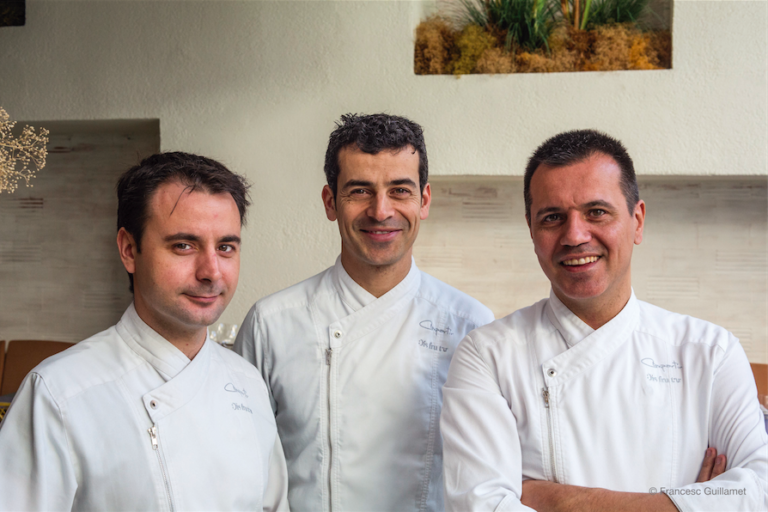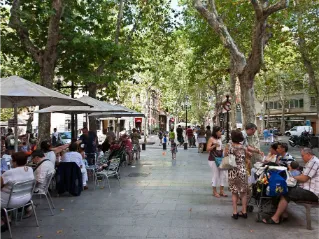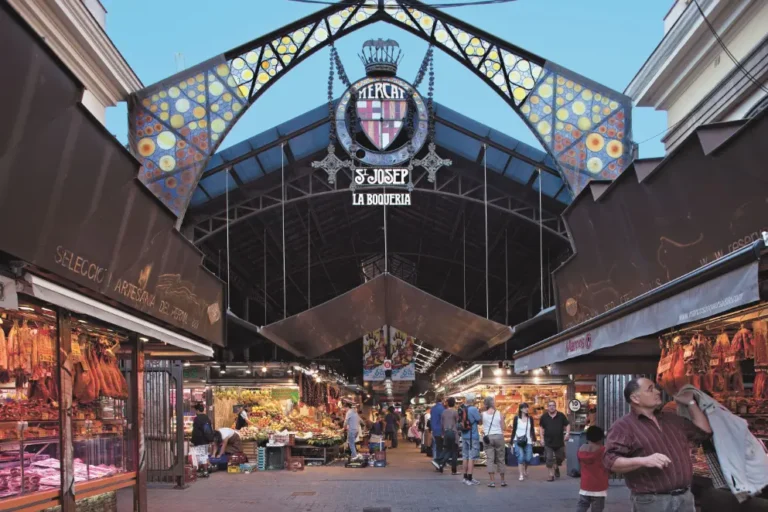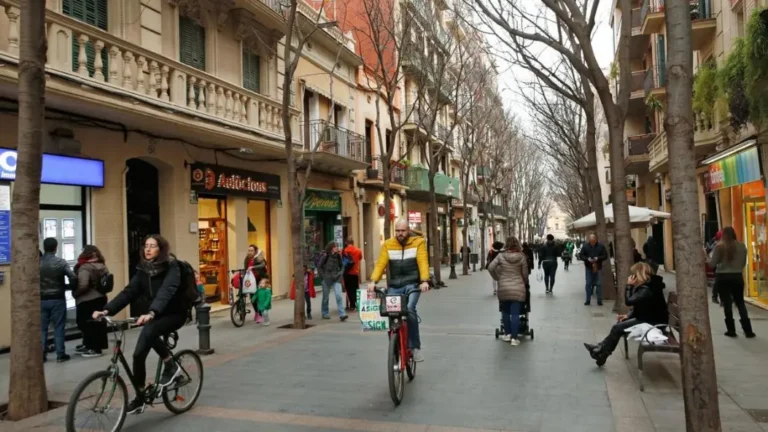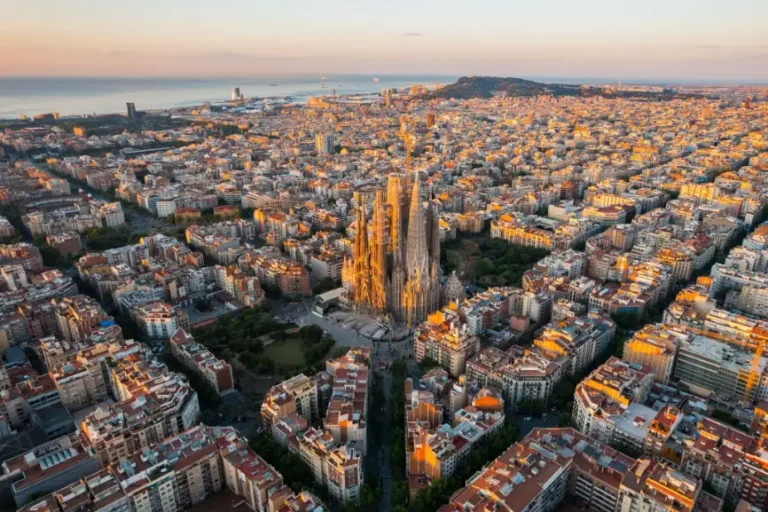Festa Major de Gràcia – Barcelona’s Most Colorful Festival
Every August, the Festa Major de Gràcia transforms this charming Barcelona neighborhood into a surreal playground of art, music, and tradition. What started in the early 19th century as a small village celebration in honor of Saint Roch has grown into one of the city’s most beloved cultural events.
A Neighborhood Transformed
For one week, the normally quiet streets of Gràcia explode with creativity. Each street competes to win the prize for best decoration (“guarnit”), working for months to design whimsical themes using paper, fabric, recycled cans, and anything else residents can dream up. The result? Entire streets turned into fantasy worlds — from enchanted forests to underwater kingdoms.
Tradition Meets Celebration
Beyond the eye-popping decorations, the festival is packed with Catalan traditions:
Castellers – human towers reaching incredible heights.
Sardana dancing – traditional circles of music and movement.
Correfoc – the fiery “devil’s run,” where sparks and firecrackers light up the night.
Concerts, street theater, and family activities keep the energy alive, while food stalls and local restaurants serve Catalan favorites like butifarra and pa amb tomàquet.
A Festival with History
The Festa Major has survived wars, crises, and even a pandemic, always returning as a symbol of community spirit. Each year’s decorations often reflect current themes — from environmental awareness to tributes to local history — proving that Gràcia’s creativity is both timeless and relevant.
Why You Can’t Miss It
More than just a party, the Festa Major de Gràcia is about community, imagination, and identity. It’s a chance to see Barcelona beyond the tourist hotspots and experience a festival built by neighbors, for neighbors — though everyone is welcome to join in.
Everything You Need to Know About The Festa Major de Gràcia

Everything You Need to Know About The Festa Major de Gràcia
Community Spirit at the Festa Major de Gràcia
From Tradition to Modern Celebration
The Festa Major de Gràcia has held onto its core traditions — elaborate street decorations, music, and Catalan cultural events — while also evolving with the times. Today, the festival features a mix of traditional sardanas and castellers alongside rock, electronic, and world music, attracting a wide and diverse audience.
Months of Preparation
Planning begins as early as January. Neighbors meet to choose themes, design decorations, and assign tasks. In the months leading up to August, community workshops fill garages and cultural centers, where residents of all ages gather to cut, paint, and build. These sessions strengthen community ties just as much as they produce the spectacular displays.
The Street Competition
The highlight is the friendly competition between streets. Each block selects a theme — from fantasy and film to history or social issues — and transforms itself into an immersive world. Judges evaluate based on creativity, craftsmanship, and originality, but the real reward is the pride and unity the process brings to the neighborhood.
A Festival by the People, for the People
At its heart, the Festa Major de Gràcia is a celebration of community spirit. Residents lead every aspect — from decorations and activities to concerts and cultural events. This shared effort not only keeps the tradition alive but also strengthens the bonds between neighbors, making the festival one of Barcelona’s most beloved celebrations.
Everything You Need to Know About The Festa Major de Gràcia
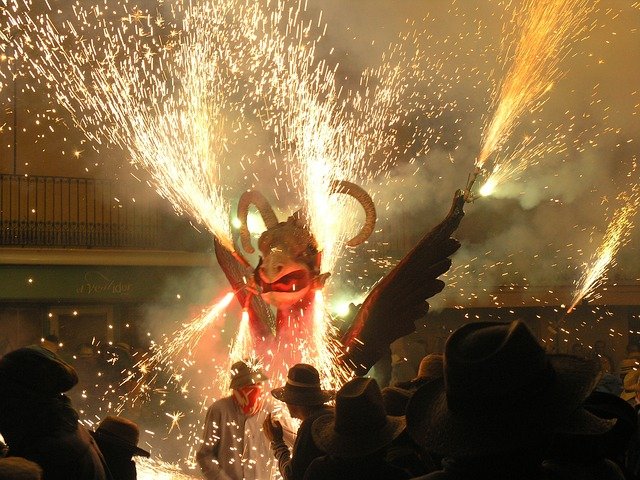
Everything You Need to Know About The Festa Major de Gràcia
The Fire Run (Correfoc)
What is the Correfoc?
One of the most thrilling highlights of the Festa Major de Gràcia is the Correfoc, or “fire run.” Costumed devils, known as diables, charge through the streets with fireworks and sparklers, showering sparks over the crowd. Rooted in medieval traditions, the event symbolizes the eternal clash between good and evil — but today it’s celebrated as a fiery, chaotic spectacle of dance, drumming, and light.
Safety and Participation
The diables wear heavy, fire-resistant clothing — hoods, gloves, and boots — to withstand the sparks (not the easiest outfit in Barcelona’s August heat). Spectators are encouraged to follow safety guidelines too: wear long sleeves, cover hair, and keep a respectful distance. Families with small children are advised to enjoy the show from further back.
Organizers work with local authorities to ensure safety, setting up barriers, posting guidelines, and stationing fire crews and medics throughout the route.
Best Viewing Spots
Want the best experience? Here are the most popular vantage points:
Plaça de la Vila de Gràcia – The square at the heart of the neighborhood, where narrow streets amplify the sparks and sound.
Carrer de Verdi – Close-up action plus plenty of bars and cafes for post-Correfoc drinks.
Plaça del Sol – A calmer, family-friendly option with open space and benches for a more relaxed view.
Why You Shouldn’t Miss It
The Correfoc is intense, loud, and unforgettable. It’s part street performance, part firestorm, and part community ritual. Whether you dive into the chaos or watch from a safe distance, it’s a must-see tradition that captures the wild spirit of Barcelona’s festivals.
Everything You Need to Know About The Festa Major de Gràcia
Best Ways to Get to Gràcia
By Public Transportation
Gràcia is one of the easiest neighborhoods in Barcelona to reach thanks to its excellent public transport links.
Metro – The L3 (Green Line) and L4 (Yellow Line) stop at Fontana and Joanic, right in the heart of Gràcia. The L7 (Brown Line, FGC) also stops at Gràcia station, giving you plenty of options.
Buses – Lines like the H6 and V17 (horizontal and vertical routes) are super useful. You can also hop on the 22, 24, or 39, which connect Gràcia to other parts of the city. Buses run frequently and let you enjoy the scenery as you go.
Tourist Bus – If you’re visiting, the Barcelona Bus Turístic has a stop in Gràcia, making it a convenient (and scenic) way to arrive.
Driving & Parking
Driving in Gràcia is… not for the faint of heart. Narrow streets, one-way systems, and limited spots make parking a real challenge. In fact, finding a street space is about as likely as being struck by lightning.
Instead, head straight to a public garage. Options include:
SABA BAMSA Gràcia Motos (Carrer de Bonavista)
NN Travessera de Gràcia (Travessera de Gràcia)
Both are secure and close to the main attractions, with hourly or daily rates.
💡 Tip: Use a parking app like Parclick or Parkimeter to book in advance, see real-time availability, and compare prices.
The Best Way Overall
Unless you absolutely need to drive, take the metro. It’s fast, cheap, and drops you right in the center of the action. Buses are a good second option if you want to enjoy the ride, while driving should be your last resort.
Everything You Need to Know About The Festa Major de Gràcia

Everything You Need to Know About The Festa Major de Gràcia
Best Plazas to Visit During the Festa Major de Gràcia
One of the highlights of the Festa Major de Gràcia is exploring its plazas, each with its own character and charm. Here are the ones you won’t want to miss:
Plaça de la Vila de Gràcia – The festival’s beating heart, marked by the iconic clock tower. Expect cultural events, live performances, and traditional dances.
Plaça del Sol – The nightlife hub, where locals and visitors gather for concerts and dance parties that spill late into the night.
Plaça del Diamant – Famous for its artistic decorations and creative themes, perfect for soaking up Gràcia’s imagination and talent.
Plaça de la Virreina – A family-friendly plaza offering children’s workshops, puppet shows, and a relaxed vibe for parents.
Plaça de Rovira i Trias – A quieter spot with thoughtful decorations, ideal if you need a break from the more crowded squares.
💡 Tip: Visit Plaça del Diamant and Plaça de la Virreina earlier in the day to enjoy the details and family activities, and head to Plaça del Sol or Plaça de la Vila in the evening when the party is in full swing.
Everything You Need to Know About The Festa Major de Gràcia
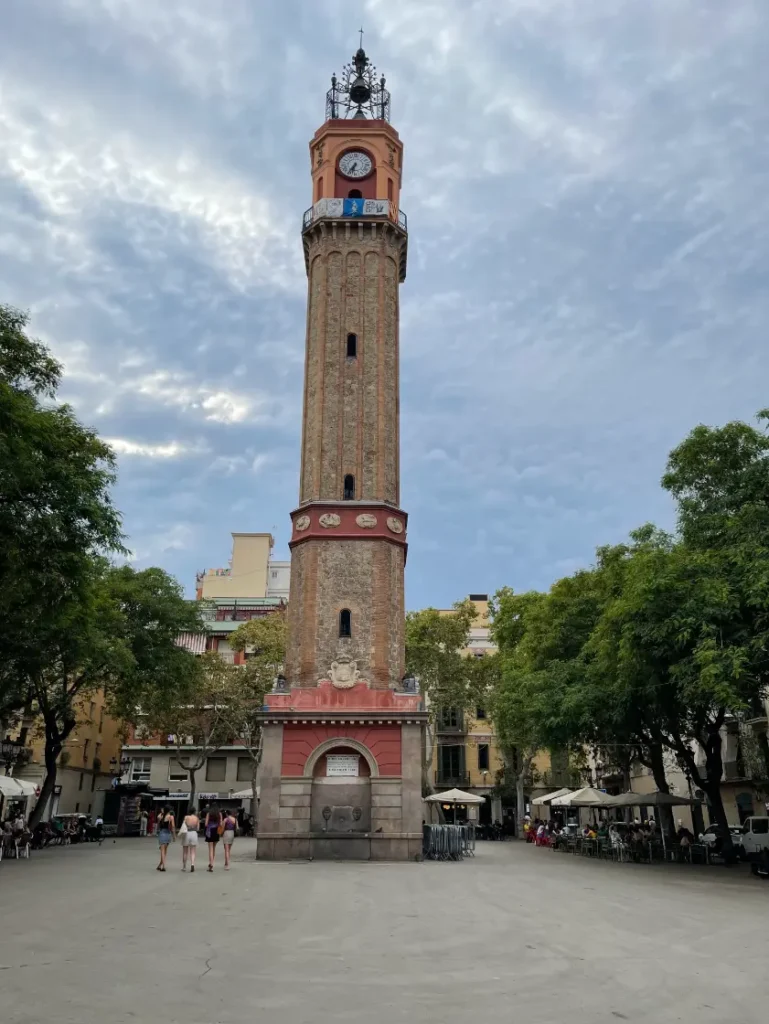
Everything You Need to Know About The Festa Major de Gràcia
Highlights of Decorations and Activities
The Festa Major de Gràcia is all about creativity and community spirit, and nowhere is this more visible than in its plazas. Each square has its own unique vibe:
Plaça de la Vila de Gràcia – The heart of the festival, marked by the iconic clock tower. Expect traditional dances, concerts, and big crowds.
Plaça del Sol – Youthful and energetic, with live music and street parties that go late into the night.
Plaça del Diamant – Known for its stunning, highly detailed decorations, often made from recycled materials.
Plaça de la Virreina – Whimsical themes and family-friendly activities like workshops and games.
Plaça de Rovira i Trias – A quieter corner, often with architecture-inspired displays, perfect for taking a breather.
💡 Tip: If you want to enjoy the details, go earlier in the day; for atmosphere and nightlife, head out after sunset.
Everything You Need to Know About The Festa Major de Gràcia
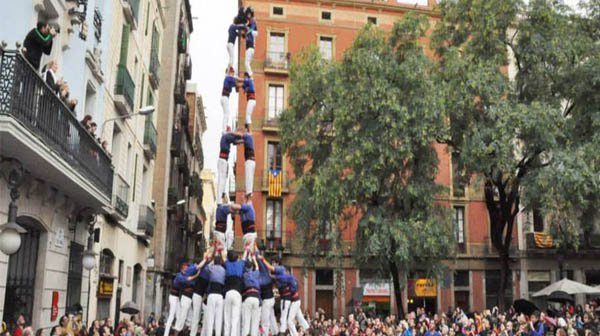
Everything You Need to Know About The Festa Major de Gràcia
Live Music, Arts & Performances
The Festa Major de Gràcia is as much about sound and movement as it is about decorations. Every corner of the neighborhood becomes a stage, offering something for everyone:
Music everywhere – From traditional Catalan folk and sardanas to indie rock, jazz, and even DJs, the lineup mixes local talent with international acts. Big stages like Plaça de la Vila de Gràcia host headline shows, while Plaça del Sol is perfect for indie vibes and late-night dancing.
Street performers & theatre – Acrobats, jugglers, dancers, and pop-up theatre groups keep the crowds entertained throughout the week.
Art installations – Gràcia transforms into a living gallery. Entire streets are decked out with themed decorations (many made from recycled materials), interactive exhibits, and vibrant street art. Daytime lets you see the details; nighttime lighting turns everything magical.
👉 Check the official schedule for daily lineups, but the truth is you’ll stumble into plenty just by wandering.
Festival Vibe & Atmosphere
What makes Festa Major de Gràcia unforgettable isn’t just the events — it’s the neighborhood energy.
Streets burst with colorful, handcrafted decorations, each competing to outdo the other.
Music and laughter spill from every plaza.
Families, friends, and travelers mix together, creating a warm and welcoming atmosphere.
It’s part street fair, part concert series, part art show — and 100% Gràcia spirit.
Everything You Need to Know About The Festa Major de Gràcia
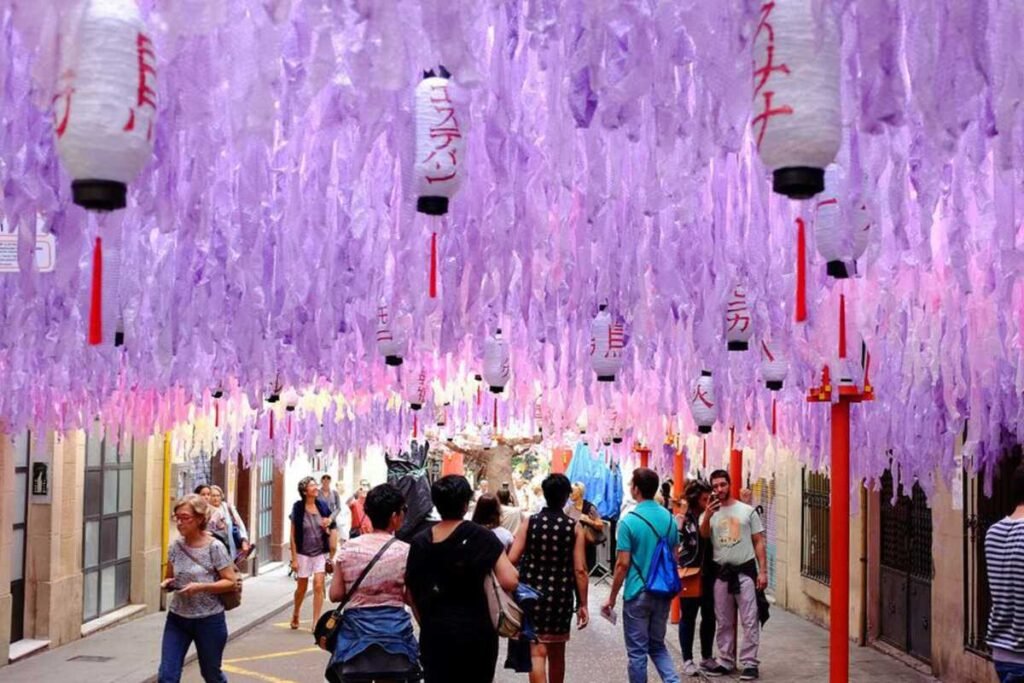
Everything You Need to Know About The Festa Major de Gràcia
What to Expect: Crowds, Noise & Energy
The Festa Major de Gràcia is lively, busy, and unforgettable. The narrow streets fill up fast, especially in the evenings, creating a buzzing mix of locals and visitors.
Crowds – Expect packed streets in hotspots like Plaça de la Vila de Gràcia and Carrer de Verdi. Afternoons are calmer; nights are shoulder-to-shoulder.
Noise – Music, laughter, street performers, and DJs create a constant soundtrack. If you want quiet, Gràcia during festival week isn’t the place.
Energy – Daytime has a relaxed, family-friendly vibe. By night, things ramp up into concerts, parties, and late-night dancing.
Tips to Enjoy the Festival
Plan your timing – Early afternoons = fewer crowds; evenings = peak atmosphere.
Wear good shoes – You’ll walk for hours.
Stay hydrated – August in Barcelona is hot. Bring a water bottle.
Snack like a local – Try street food and Catalan classics from pop-up stalls.
Get curious – Chat with residents; they’re proud of their street decorations.
Bring your camera – Every corner has a photo-worthy surprise.
Who It’s Great For
Families – Visit in the morning, join kid-friendly workshops, and enjoy puppet shows or early concerts.
Solo Travelers – Wander the decorated streets, join a tour, and dive into the nightlife to meet new people.
Couples – Stroll hand-in-hand, share tapas, then dance under the lights.
Groups of Friends – Explore together by day, then hit the live music and street parties by night.
Everything You Need to Know About The Festa Major de Gràcia

Everything You Need to Know About The Festa Major de Gràcia
Local Tips for First-Time Visitors
Arrive Early: Streets and plazas fill up fast.
Skip the Car: Use the metro or bus (parking is a nightmare).
Talk to Locals: Graciencs love to share stories.
Stay Hydrated: It’s hot and humid in August — water is your best friend.
Take Breaks: Duck into quieter plazas or cafés to recharge.
Eat Local: Grab Catalan classics from food stalls or neighborhood restaurants.
Best Times to Visit
Opening Night (Aug 15th): Streets are unveiled, energy is sky-high.
Weekend Highlights: Fire runs (Correfoc) and human towers (Castellers) pack the biggest crowds.
Midweek: Quieter but still buzzing with concerts and workshops.
Final Night: Fireworks send the festival out with a bang.
👉 Pro tip: Visit in the mornings or weekday afternoons if you want fewer crowds and better photo ops.
Memorable Festival Moments
Every year brings surprises, but a few legends live on:
The Eternal Underdog Street: Never wins the decoration contest, but shows up every year with heart.
The Year of the Giants: Massive puppets paraded through the streets — unforgettable.
Rainy Fire Run: A sudden downpour turned the Correfoc into a joyful street dance.
Neighborly Unity: Rival streets once joined forces to create a breathtaking joint display.









